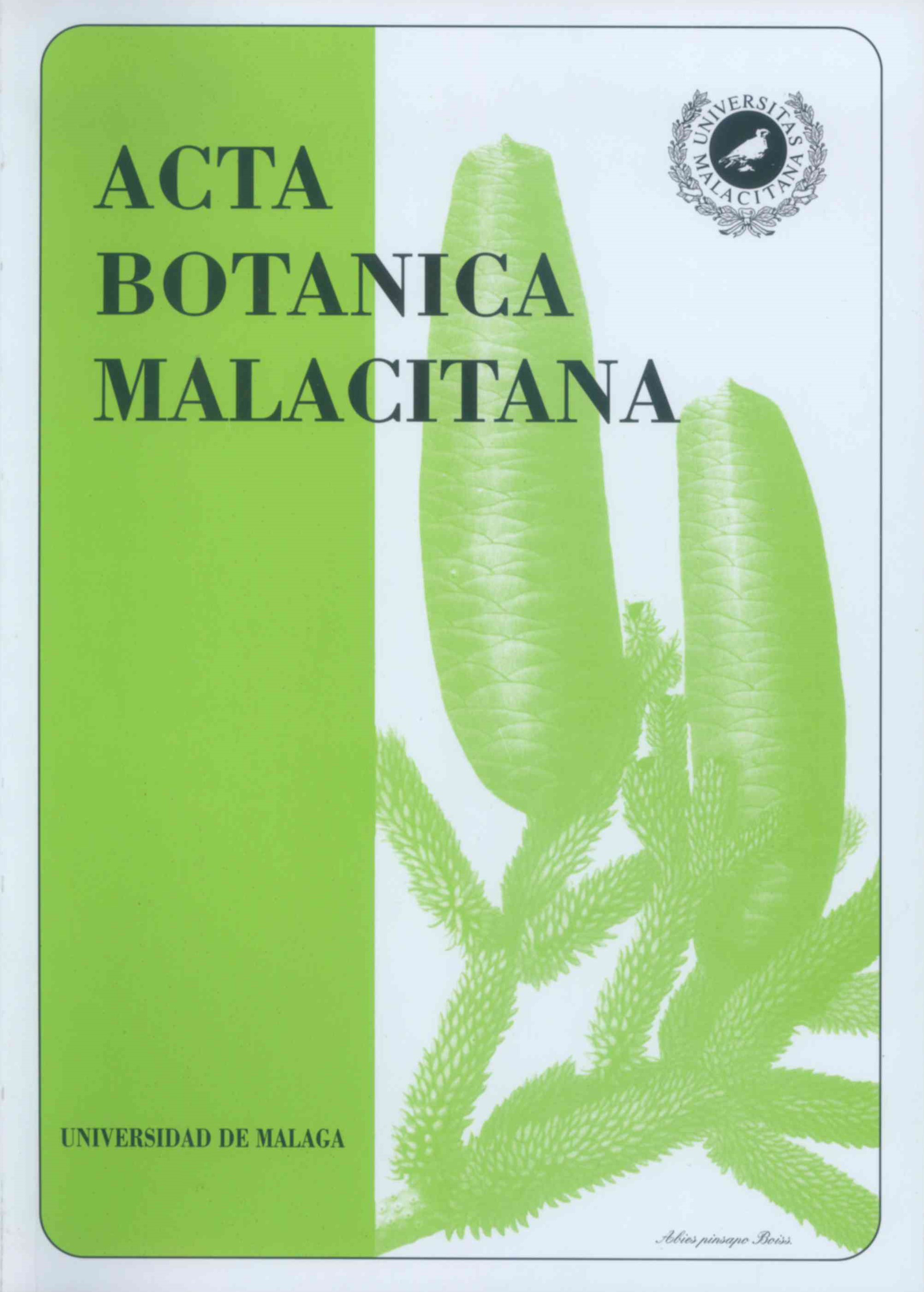Análisis de componentes principales sobre datos multiespectrales “Landsat-TM” e interpretación de cubiertas vegetales en las Sierras de Tejeda y Almijara
DOI:
https://doi.org/10.24310/abm.v20i.8846Palabras clave:
Andalucía, España, teledetección, A.C.P., nálisis de Componentes Principales, cubiertas vegetales, Landsat-TMResumen
La consideración simultánea de todas las bandas de reflectancia en el análisis de imágenes multiespectrales teledetectadas, representa un incremento en el volumen de datos a procesar proporcionalmente mucho mayor que la ganancia real de información que se consigue, lo que se debe a la elevada correlación existente entre aquéllas. En este trabajo se aplica un análisis de componentes principales a datos multiespectrales Landsat TM de las Sierras de Tejeda y Almijara, con el objeto de sumarizar los mismos sin una pérdida significativa de información. Los dos primeros componentes principales obtenidos recogieron más del 99% de la varianza total original. La imagen que se obtuvo a partir del primer componente principal representaba, aproximadamente, una suma ponderada de todas las intensidades de reflectancia en las distintas bandas consideradas (análoga, por tanto, a una fotografía en blanco y negro con una extensión en el infrarrojo) y mostró una interpretabilidad óptima para aspectos de topografía-relieve, red de drenaje y tipos litológicos. La imagen resultante del segundo componente principal (ya sin efecto de relieve) mostró la intensidad de señal "verde" del dosel vegetal y se correlacionaba significativamente con las obtenidas de la aplicación de índices espectrales de vegetación (RVI, NDVI) a los datos originales. El análisis preliminar de las imagenes indica problemas de deforestación grave en la zona (casi un 30% de la superficie con suelos desnudos, y hasta un 85% si se incluyen areas con vegetación dispersa). El análisis multivariado se ha confirmado como una herramienta útil para la interpretación de imágenes teledetectadas de la zona de estudio. Eventualmente, la obtención de la transformación de componentes principales por medio de un muestreo selectivo, proveería de algoritmos de transformación para los datos multiespectrales con los que se podría, por ejemplo, hacer un seguimiento de cambios en procesos tales como la deforestación.
Descargas
Métricas
Citas
ASRAR G., M. FUCHS, E.T. KANEMASN & J.L. HATFIELD -1984- Estimating absorbed photosynthetic radiation and leaf area index from spectral reflectance in wheat. Agronomy Journal, 76:300-306.
AVERY T.E. & G.L. BERLIN -1985- Fundamentals of remote sensing and airphoto interpretation. MacMillan. 472 pp.
COLWELL, J.E. -1974- Vegetation canopy reflectance. Remote Sensing of the Environment, 3: 175-183.
CHUVIECO, E. -1990- Fundamentos de teledetección espacial. Ed. Rialp, Madrid. 455 pp.
DONKER N.H.W & N.J. MULDER -1976- Analysis of MSS digital imagery with the aid of principal component transform. ISP Commission VII.
ELORZA J.J., V. GARCÍA-DUEÑAS, J. MATAS & L. MARTÍN -1979- Hoja geológica de Zafarraya (18-43). Mapa Geológico de España, 1:50000. IGME.
ELVIDGE C.D. & R.J.P. LYON -1985- Influence of rock-soil spectra variation on the assesment of green biomass. Remote Sensing of the Environment, 17: 265-279.
HUETE A.R. -1988- A soil-adjusted vegetation index. Remote Sensing of the Environment, 25: 295-309.
HUETE A.R., R.D. JACKSON & D.F. POST -1985- Spectral response of a plant canopy with different soil backgrounds. Remote Sensing of the Environment, 17: 37-53.
HUETE A.R. & R.D. JACKSON -1987- Suitability of spectral indices for evaluating vegetation characteristics on arid rangelands. Remote Sensing of the Environment, 23:213-232.
MULDER N.J. -1974- Data compresion and data reduction techniques for the visual interpretation of multiespectral images. ITC-Journal, 1974-3.
NIETO J.M. -1987- Estudio fitocenológico de las Sierras de Tejeda y Almijara (Málaga- Granada). Tesis doctoral, Universidad de Malaga. 557 pp.
ORTUÑO F. & A. CEBALLOS -1977- Los bosques españoles. Ed. Incafo, Madrid. 251 pp.
RINGROSE S. & W. MATHESON -1987- Spectral assesment of indicators of range degradation in the Botswana hardveld environment. Remote Sensing of the Environment, 23: 379-396.
SABINS F.F. -1987- Remote sensing: Principles and interpretation. Freeman, New York. 449 p.
SELLERS P.J. -1985- Canopy reflectance, photosynthesis and transpiration. Int. Journal of Remote Sensing, 6:1335-1372.
TUCKER C.J. -1979- Red and photographic infrared linear combinations for monitoring vegetation. Remote Sensing of the Environment, 8:127-150.
Descargas
Publicado
Cómo citar
Número
Sección
Licencia
Los autores/as que publiquen en esta revista aceptan los siguientes términos:
- Retención de derechos.
Los autores/as conservarán sus derechos de autor y otorgarán a la revista un derecho de distribución no exclusivo para la primera publicación de su obra. - Licencia de uso.
Los artículos se publican bajo la licencia Creative Commons Attribution 4.0 (CC BY 4.0). Esta licencia permite a cualquier persona compartir y adaptar la obra siempre que se reconozca la autoría y se incluya un enlace a la licencia. - Derechos de reutilización de los autores.
Los autores pueden reutilizar, distribuir y archivar la versión publicada de su artículo sin restricciones. Se recomienda su depósito en repositorios institucionales, redes sociales científicas, blogs personales y otros medios, lo que favorece su visibilidad y citación dentro de la comunidad académica. - Fomento de la difusión.
Se permite y recomienda a los autores/as compartir su trabajo en plataformas en línea antes y durante el proceso de envío. Esto puede fomentar el intercambio académico y aumentar la difusión y el impacto de la obra publicada.








1.png)
